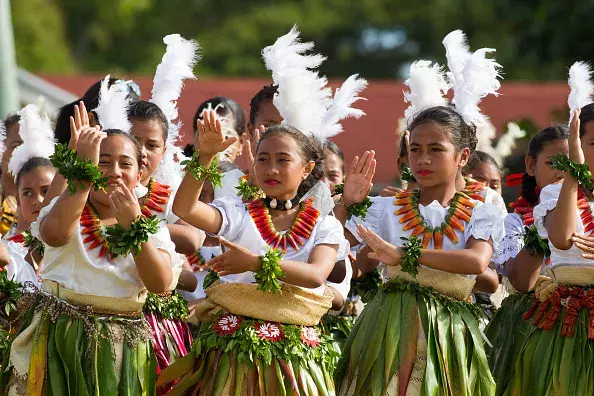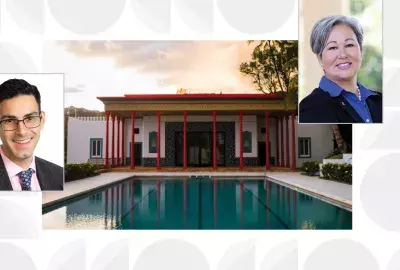Error message

OFFICE/DEPARTMENT
Panelists explore issues surrounding Pacific out-migration
Quick take:
- More than 2 out of 5 Marshall Islanders now live in the US
- COVID mortality among Marshallese in the US has been higher per capita than any other ethnic group
- Mobility is part of Pacific Islanders’ history, speakers said, and does offer positive opportunities along with challenges
HONOLULU (Sept. 22, 2022) – Migration continues to expand the Marshallese diaspora in the United States, Marshall Islands Ambassador to the US Gerald Zackios said in a recent East-West Center forum, with economic factors playing a primary role in drawing people from their home islands even as the pandemic takes a high toll in US communities where many relocate.
Several speakers addressed the current status of migrants from Pacific Islands during a panel held in connection with the 12th Pacific Islands Conference of Leaders convened by the Pacific Islands Development Program at the East-West Center, in partnership with the Center for Pacific Islands Studies at the University of Hawaiʻi at Mānoa, in Honolulu Sept. 12-14.
Sobering COVID mortality
“It is a sobering fact that, per capita, more of our citizens died from COVID-19 than any other racial group,” Zackios said.
The high mortality numbers attracted wider attention to the pre-existing inequities in health care affecting Pacific Islanders in the US, but systemic problems remain. “We need more Marshallese doctors, nurses, translators, who can help our people and also help educate their US counterparts on our unique challenges,” the ambassador said.
Many Marshallese migrate to the US for better health care, some because of illnesses stemming from nuclear testing conducted by the American military during the 1940s and 1950s. But Zackios said the greatest factor spurring migration from the Marshall Islands is economic opportunity.
Under bilateral treaties known as Compacts of Free Association (COFA), citizens of the Marshall Islands, Micronesia, and Palau can work and live visa-free in the US indefinitely. The Government Accountability Office wrote in a 2020 report that more than 94,000 COFA citizens, their children, and grandchildren live in the US and its territories.
Zackios said officials are awaiting the latest 2020 census count for the Marshallese population, but preliminary data suggest that for every four Marshallese residing in their homeland, three live in the US, particularly in Hawaiʻi, Oregon, Washington State, and Arkansas.
The ambassador praised a recently released paper by the US Committee for Refugees and Immigrants calling for expanded federal benefits to help COFA citizens. The committee notes the compacts are set to expire at the end of fiscal year 2023 for the Marshall Islands and Micronesia and fiscal year 2024 for Palau. While provisions covering migration, security, and defense will remain, certain economic assistance to the island nations and federal grants to areas with large COFA populations are set to end, according to the committee.
Climate change contribution
Climate change remains an existential threat to the Marshall Islands, where there is no elevation higher than six feet above sea level. But Zackios said the environmental ties to migration require more study.
Research reported in 2020 by the United Nations University Institute for Environment and Human Security found Marshallese rarely mentioned climate change and environmental issues when asked why they migrate. Nonetheless, the same research showed the more climate-stressed households recorded higher migration rates. A recent study by East-West Center researchers also found that changing climate has resulted in both direct and indirect health impacts in the Marshall Islands, and migration can be one result.
Zackios identified the possible loss of Marshallese culture as an emerging issue with out-migration. “Our Marshallese language is at risk of being lost as our young children speak English more than Marshallese,” he said. Thankfully, Marshallese communities he has visited in the US continue their traditional customs, while adjusting to regulations such as noise limits during large celebrations, the ambassador said.
The diaspora experience is not only about negatives, however. Zackios said that Marshallese contribute substantially to economies in states where they are employed and graduate from universities and technical trade schools. Remittances are also on the rise, as those in the US send funds back home to their families in the Marshalls. Advocacy has also improved policy decisions, including a critical restoration of Medicaid benefits to COFA citizens contained in a spending package signed in December 2020.
Reframing ʻdiasporaʻ
Tammy Tabe, Oceania research fellow at the East-West Center, said the focus is often on the challenges faced by the diaspora rather than the opportunities and ways in which Pacific Islanders can celebrate themselves.
“I think it's really, really important to start reframing these concepts and align them to how we see ourselves and relate to others beyond our islands,” Tabe said.
She told students in the audience that discovering identity is about navigating, and the Pacific diasporas are not scattered, as typically viewed. “They are people that have gone before us to create those bridges and pathways so that the rest of us can have an easier way to travel to other parts of the world.”
Mobility is a part of Pacific Islanders’ history, agreed Tevita Ka‘ili, professor with the Brigham Young University-Hawaiʻi faculty of culture, language and performing arts. He said Tongans are in their third diaspora wave, having migrated during previous periods of time.
Even when Tongans migrate, they work to keep their island identity, said Ka‘ili. “There's a strong desire with Tongans in the diaspora to continue to maintain both language and culture.”
Panel moderator Vidalino Raatior from San Jose State University offered another view of the diaspora experience: migrants facing challenges abroad become stronger. “The Pacific diaspora is resilient in an ever-changing landscape of anti-immigrant sentiments, where nationalism often excludes the voices of those who are viewed as not full members of society,” he said.
Raatior said members of the diaspora also remain connected to their homelands, and he called on Pacific Island leaders to help them build the bridge started by those who went before them.
Panelists explore issues surrounding Pacific out-migration
Quick take:
- More than 2 out of 5 Marshall Islanders now live in the US
- COVID mortality among Marshallese in the US has been higher per capita than any other ethnic group
- Mobility is part of Pacific Islanders’ history, speakers said, and does offer positive opportunities along with challenges
HONOLULU (Sept. 22, 2022) – Migration continues to expand the Marshallese diaspora in the United States, Marshall Islands Ambassador to the US Gerald Zackios said in a recent East-West Center forum, with economic factors playing a primary role in drawing people from their home islands even as the pandemic takes a high toll in US communities where many relocate.
Several speakers addressed the current status of migrants from Pacific Islands during a panel held in connection with the 12th Pacific Islands Conference of Leaders convened by the Pacific Islands Development Program at the East-West Center, in partnership with the Center for Pacific Islands Studies at the University of Hawaiʻi at Mānoa, in Honolulu Sept. 12-14.
Sobering COVID mortality
“It is a sobering fact that, per capita, more of our citizens died from COVID-19 than any other racial group,” Zackios said.
The high mortality numbers attracted wider attention to the pre-existing inequities in health care affecting Pacific Islanders in the US, but systemic problems remain. “We need more Marshallese doctors, nurses, translators, who can help our people and also help educate their US counterparts on our unique challenges,” the ambassador said.
Many Marshallese migrate to the US for better health care, some because of illnesses stemming from nuclear testing conducted by the American military during the 1940s and 1950s. But Zackios said the greatest factor spurring migration from the Marshall Islands is economic opportunity.
Under bilateral treaties known as Compacts of Free Association (COFA), citizens of the Marshall Islands, Micronesia, and Palau can work and live visa-free in the US indefinitely. The Government Accountability Office wrote in a 2020 report that more than 94,000 COFA citizens, their children, and grandchildren live in the US and its territories.
Zackios said officials are awaiting the latest 2020 census count for the Marshallese population, but preliminary data suggest that for every four Marshallese residing in their homeland, three live in the US, particularly in Hawaiʻi, Oregon, Washington State, and Arkansas.
The ambassador praised a recently released paper by the US Committee for Refugees and Immigrants calling for expanded federal benefits to help COFA citizens. The committee notes the compacts are set to expire at the end of fiscal year 2023 for the Marshall Islands and Micronesia and fiscal year 2024 for Palau. While provisions covering migration, security, and defense will remain, certain economic assistance to the island nations and federal grants to areas with large COFA populations are set to end, according to the committee.
Climate change contribution
Climate change remains an existential threat to the Marshall Islands, where there is no elevation higher than six feet above sea level. But Zackios said the environmental ties to migration require more study.
Research reported in 2020 by the United Nations University Institute for Environment and Human Security found Marshallese rarely mentioned climate change and environmental issues when asked why they migrate. Nonetheless, the same research showed the more climate-stressed households recorded higher migration rates. A recent study by East-West Center researchers also found that changing climate has resulted in both direct and indirect health impacts in the Marshall Islands, and migration can be one result.
Zackios identified the possible loss of Marshallese culture as an emerging issue with out-migration. “Our Marshallese language is at risk of being lost as our young children speak English more than Marshallese,” he said. Thankfully, Marshallese communities he has visited in the US continue their traditional customs, while adjusting to regulations such as noise limits during large celebrations, the ambassador said.
The diaspora experience is not only about negatives, however. Zackios said that Marshallese contribute substantially to economies in states where they are employed and graduate from universities and technical trade schools. Remittances are also on the rise, as those in the US send funds back home to their families in the Marshalls. Advocacy has also improved policy decisions, including a critical restoration of Medicaid benefits to COFA citizens contained in a spending package signed in December 2020.
Reframing ʻdiasporaʻ
Tammy Tabe, Oceania research fellow at the East-West Center, said the focus is often on the challenges faced by the diaspora rather than the opportunities and ways in which Pacific Islanders can celebrate themselves.
“I think it's really, really important to start reframing these concepts and align them to how we see ourselves and relate to others beyond our islands,” Tabe said.
She told students in the audience that discovering identity is about navigating, and the Pacific diasporas are not scattered, as typically viewed. “They are people that have gone before us to create those bridges and pathways so that the rest of us can have an easier way to travel to other parts of the world.”
Mobility is a part of Pacific Islanders’ history, agreed Tevita Ka‘ili, professor with the Brigham Young University-Hawaiʻi faculty of culture, language and performing arts. He said Tongans are in their third diaspora wave, having migrated during previous periods of time.
Even when Tongans migrate, they work to keep their island identity, said Ka‘ili. “There's a strong desire with Tongans in the diaspora to continue to maintain both language and culture.”
Panel moderator Vidalino Raatior from San Jose State University offered another view of the diaspora experience: migrants facing challenges abroad become stronger. “The Pacific diaspora is resilient in an ever-changing landscape of anti-immigrant sentiments, where nationalism often excludes the voices of those who are viewed as not full members of society,” he said.
Raatior said members of the diaspora also remain connected to their homelands, and he called on Pacific Island leaders to help them build the bridge started by those who went before them.
East-West Wire
News, Commentary, and Analysis
The East-West Wire is a news, commentary, and analysis service provided by the East-West Center in Honolulu. Any part or all of the Wire content may be used by media with attribution to the East-West Center or the person quoted. To receive East-West Center Wire media releases via email, subscribe here.
For links to all East-West Center media programs, fellowships and services, see www.eastwestcenter.org/journalists.







